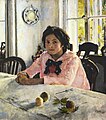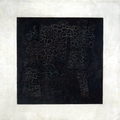Tretyakov Gallery
Cite error: There are <ref> tags on this page without content in them (see the help page).
| File:The State Tretyakov Gallery.jpg | |
 | |
| Established | 1856 |
|---|---|
| Location | Moscow, Russia |
| Type | Art museum |
| Website | www.tretyakov.ru |
The State Tretyakov Gallery (Russian: Государственная Третьяковская Галерея, Russian: ГТГ) is an art gallery in Moscow, Russia, the foremost depository of Russian fine art in the world.
The gallery's history starts in 1856 when the Moscow merchant Pavel Mikhailovich Tretyakov acquired works by Russian artists of his day with the aim of creating a collection, which might later grow into a museum of national art. In 1892, Tretyakov presented his already famous collection of approximately 2,000 works (1,362 paintings, 526 drawings, and 9 sculptures) to the Russian nation.[1][2]
The façade of the gallery building was designed by the painter Viktor Vasnetsov in a peculiar Russian fairy-tale style. It was built in 1902–04 to the south from the Moscow Kremlin. During the 20th century, the gallery expanded to several neighboring buildings, including the 17th-century church of St. Nicholas in Tolmachi.
The collection contains more than 130,000 exhibits, ranging from Theotokos of Vladimir and Andrei Rublev's Trinity to the monumental Composition VII by Wassily Kandinsky and the Black Square by Kazimir Malevich.
In 1977 the Gallery kept a significant part of the George Costakis collection.
In May 2012, the Tretyakov art Gallery played host to the prestigious FIDE World Chess Championship between Vishwanathan Anand and Boris Gelfand as the organizers felt the event would promote both chess and art at the same time.[3]
Gallery of modern art

In 1985, the Tretyakov Gallery was administratively merged with a gallery of contemporary art, housed in a large modern building along the Garden Ring, immediately south of the Crimean Bridge. The grounds of this branch of the museum contain a collection of Socialist Realism sculpture, including such highlights as Yevgeny Vuchetich's iconic statue of "Iron Felix" (which was removed from Lubyanka Square in 1991), the "Swords Into Plowshares" sculpture representing a nude worker forging a plough out of a sword, and the "Young Russia" monument. Nearby is Zurab Tsereteli's 86-metre-tall statue of Peter the Great, one of the tallest outdoor statues in the world.
Near the Gallery of modern art there is a sculpture garden called "the graveyard of fallen monuments" that displays statues of former Soviet Union that were relocated.
There are certain plans to demolish the gallery constructed in the late Soviet modernism style, though the public opinion is strongly against them.[4][5]
References
- ^ Korolev & Iovleva (1992), 13
- ^ "The donation of the Gallery to Moscow, 1892-1898". The State Tretyakov Gallery website. Accessed 24 March 2012.
- ^ http://www.mark-weeks.com/chess/a8b0$wix.htm
- ^ House of Artists not only for Artists, Moscow Time, November 5, 2009
- ^ "Moscow Cultural Landmark Is Seen as Threatened". NY Times. Accessed 24 March 2012.
Sources
- Korolev, Yuri Konstantinovich & Iovleva, Lydia Ivanova (1992). The Tretyakov Gallery. Moscow, Russia: Izobrazitelnoye Iskusstvo Publishers. ISBN 9785852001771
Gallery
-
Theotokos of Vladimir (XII century)
-
Andrei Rublev, Trinity (1411 or 1423-25)
-
Valentin Serov, The girl with peaches (1887)
-
Nikolai Ge, Quod Est Veritas? (1890)
-
Victor Vasnetsov, Bogatyrs (1898)
-
Nicholas Roerich, Guests from Overseas (1901)
External links
- Official Website of the Tretyakov Gallery
- Masterpieces from the Tretyakov Gallery
- Icons from the collection of the Tretyakov Gallery
- Visiting the Tretyakov - Useful information including opening times and contact details
- Template:Ru icon Museon official website, an open-air sculpture exhibition
- State Tretyakov Gallery of XX century contemporary art, Flickr group












